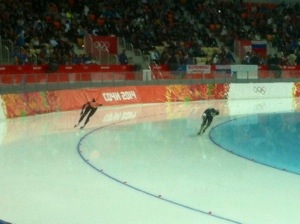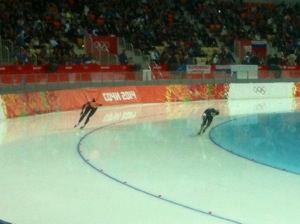Day 3 was a beautiful, mostly sunny day in Russia and I want to see the Women’s 5,000 meter speed skating event. 5,000 meters is a little over 3 miles. It’s the longest of the women’s speed skating events and it takes the best in the world a little under seven minutes to complete the race.
The race took place in Adler Arena (hooray Adler! That’s the town I’m staying in) and my first impression was, “whoa! that’s a long rink!” The speed skating track is a skinny, elongated oval 400 meters around. So the race was a little more than 12 laps. Although there are only about a dozen rows back, because the rink is so long, the arena holds 8,000 people and tonight it was pretty much packed. The fans were predominantly Russian but after that, dominated by the Dutch. The Dutch, who are traditionally and currently dominant in speed skating were out in full force and it seemed to me as if the arena had actually been designed for them. There was a clear orange motif (the color of the Dutch) throughout — orange seats, orange boards around the rink, etc.
I had never seen speed skating in person before and I was impressed. The skaters flew around the rink and, given that this is the longest distance race, I can only imagine how much faster they go in the sprints. When the crowd was not roaring for a Russian skater, the arena was so quiet that you could distinctly hear the snicks of the skates digging into the ice as a racer went by.
Speed skating is all about efficiency. The less the racer moves, the faster they are able to go. You’ve probably seen speed skaters tuck one arm behind their backs on TV. In person I noticed that some of the racers had a thin rope tied around their waists so that they could loop their thumb into it behind their backs to take a little strain off that arm. Of course, uninitiated spectators like me think that a racer who is moving more is probably going faster. It’s actually the opposite. The faster they look, the slower they are going. As some of the racers got tired, you could notice their heads bobbing slightly and their arms whipping about a little more. Any wasted movement is counter productive but it’s natural that as you get tired, you lose the ability to control every motion so carefully.
The best of the best skated aerodynamically throughout. It’s amazing how angular the racers look while they are skating — their bodies remain at close to a ninety degree angle the whole time. Even after they finish, and are trying their best to catch their breath, they stay bent over like that. It’s only when they finally stand up straight that you go, “whoa!!” and remember that this sport is powered primarily by the butt. The only real exception to this rule was the winner of the competition, a skater from the Czech Republic named Martina Sablikova who looked far to stick-like to have the power for this sport. I suppose, like Usain Bolt who is “far too tall for a sprinter,” the best are sometimes outliers even from a population of outliers.
I have to give a lot of credit to the speed skating crowd. As I said, the size and shape of the arena made it hard to feel connected to the rest of the fans but when a Russian woman was skating there was a roar of cheering and flag waving that looped around the course just ahead of her like the crowd was doing the wave at Olympic record pace. As the Dutch woman I was sitting next to said, “when you yell at her, she goes faster.” She added that “all Dutch people are like that” but I think it probably applies the same to Russians because it seemed like the Russian skaters took energy from the crowd. The best of the Russian skaters just missed the podium by 11 hundredths of a second. Heartbreaking, especially because the crowd must have known that its beloved Russian Men’s Ice Hockey team was losing to Finland at the same time.
Up next, Curling!



Thanks for bringing the games to life with your words!
Great descriptions – wonderful to have an inside look at the Olympic experience.